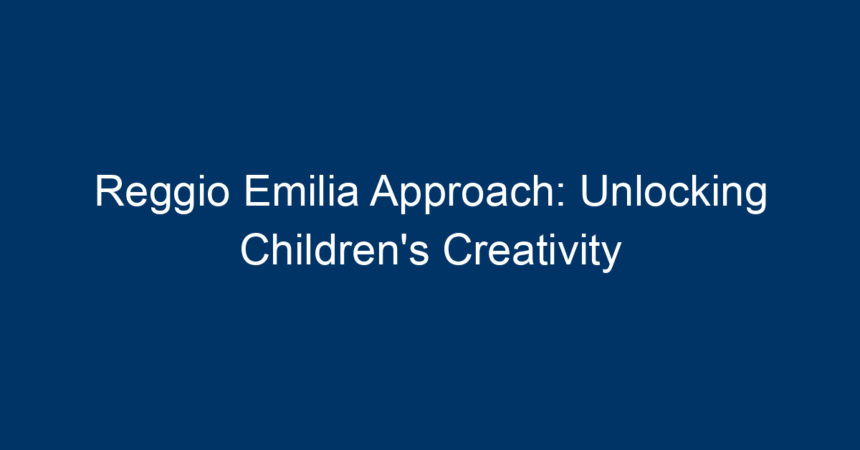Introduction
In a rapidly changing world, the need for creativity and critical thinking in education has never been more crucial. One of the most innovative educational philosophies designed to foster these essential skills is the Reggio Emilia approach. Originating in post-World War II Italy, this child-centered approach emphasizes the importance of community, collaboration, and the arts in nurturing children’s creativity. In this article, we dive deep into the Reggio Emilia approach, exploring its core principles and how it successfully unlocks children’s creative potential.
What is the Reggio Emilia Approach?
The Reggio Emilia approach is an educational philosophy developed by Loris Malaguzzi and embraced by the community of Reggio Emilia, Italy. It is not a formal curriculum but a framework that encourages educators to prioritize children’s natural curiosity, autonomy, and creativity. This approach values children as active participants in their learning journey, providing them with opportunities to express themselves through multiple “languages,” including art, music, and movement.
Core Principles of the Reggio Emilia Approach
-
Child-Centered Learning
- At the heart of the Reggio Emilia approach is the belief that children are competent and capable learners. They are seen as individuals who can shape their own learning experiences. By observing children’s interests, educators can tailor activities that resonate with each child’s unique curiosity.
-
The Importance of Environment
- The Reggio Emilia approach emphasizes a thoughtfully designed environment. Spaces are created to inspire creativity, featuring natural materials, open layouts, and areas for collaborative play. Classrooms often resemble galleries, showcasing children’s work and ideas, reinforcing their sense of ownership over their learning.
-
Collaboration and Community
- The role of the community is pivotal in the Reggio Emilia approach. Parents, educators, and the larger community collaborate to enrich children’s learning experiences. This partnership fosters a sense of belonging and encourages children to understand their place within a larger context.
-
The Arts as Expression
- Art is considered a fundamental way for children to express their feelings, thoughts, and ideas. In the Reggio Emilia approach, children engage in various artistic activities, allowing them to communicate and explore concepts creatively. This integration of the arts emphasizes that creativity is not limited to traditional mediums; it encompasses a wide range of expressions.
- Documentation of Learning
- Documentation plays a crucial role in the Reggio Emilia approach. Educators carefully observe and record children’s interactions, projects, and progress. This documentation not only serves as a reflection tool for teachers and parents but also empowers children to revisit and reflect on their learning journey.
The Role of Educators in the Reggio Emilia Approach
Facilitators of Learning
In the Reggio Emilia approach, educators act as facilitators rather than traditional instructors. They observe children’s interactions, interests, and questions, guiding them in their explorations. By posing open-ended questions and encouraging dialogue, educators promote deep thinking and inquiry.
Encouraging Autonomy and Choice
Empowering children to make choices is a defining feature of this approach. Educators provide various materials and resources, allowing children to select how they want to engage with them. This autonomy fosters a sense of responsibility and cultivates creative problem-solving skills.
Building Relationships
Strong relationships between educators, children, and families are fundamental to the Reggio Emilia approach. Educators invest time in understanding each child’s background, interests, and learning styles. This knowledge allows them to create personalized learning experiences that resonate with each child’s unique perspective.
The Impact of the Reggio Emilia Approach on Creativity
Encouraging Exploration and Innovation
Children in a Reggio Emilia setting feel empowered to explore, innovate, and experiment. The absence of strict guidelines allows them to take risks and approach problems from different angles. This open-mindedness enhances their ability to think creatively and develop innovative solutions.
Fostering Emotional Intelligence
The emphasis on collaboration and community nurtures emotional intelligence in children. They learn to express their feelings, show empathy towards others, and work harmoniously in groups. These skills are essential for creative collaboration and are transferable to various aspects of life.
Integrating Critical Thinking
The Reggio Emilia approach emphasizes inquiry-based learning, whereby children are encouraged to ask questions and seek answers. This process of exploration nurtures critical thinking, allowing children to analyze, evaluate, and synthesize information rather than regurgitate facts.
Practical Applications of the Reggio Emilia Approach
Planning Activities
When implementing the Reggio Emilia approach, consider the following actionable steps:
-
Observe and Document
- Begin by observing children’s interests, interactions, and questions. Document these observations to identify themes or projects that resonate with the group.
-
Create Collaborative Projects
- Foster collaboration by planning projects that require teamwork and communication. This enables children to share ideas and work together creatively.
-
Value the Environment
- Design spaces that inspire creativity. Incorporate natural materials and adaptable furniture to encourage exploration and experimentation.
-
Integrate the Arts
- Include diverse artistic mediums in daily activities. Allow children to express their understanding through painting, sculpture, dance, and other art forms.
- Engage Families and Community
- Build partnerships with families and the community. Involve parents in the learning process and invite community members to share their expertise and knowledge.
Challenges and Considerations
While the Reggio Emilia approach offers numerous benefits, it is essential to acknowledge its challenges.
Teacher Training
Educators must receive appropriate training to effectively implement the Reggio Emilia approach. Professional development should focus on child development, art integration, and collaborative teaching strategies.
Balancing Curriculum Requirements
For some educators, balancing the Reggio Emilia philosophy with standardized curriculum requirements can be challenging. Finding a cohesive way to integrate both can enhance educational outcomes without sacrificing the core principles of this approach.
Community Buy-In
The success of the Reggio Emilia approach relies heavily on community engagement. Building support from families and local organizations is vital to creating a sustainable educational environment.
Conclusion: Unlocking the Future of Education
The Reggio Emilia approach revolutionizes the way we think about early childhood education. By placing children’s creativity at the forefront, it fosters a love for learning, exploration, and collaboration. Educators who embrace this philosophy can profoundly impact children’s lives, nurturing not only their academic skills but also their emotional intelligence and creative potential.
Actionable Insights
-
Start Small: Begin by integrating elements of the Reggio Emilia approach into your classroom or home environment, focusing on observation and documenting children’s interests.
-
Encourage Collaboration: Foster teamwork and communication among children through group projects that allow for creative expression.
-
Continue Learning: Seek professional development opportunities related to the Reggio Emilia approach to enhance your skills and understanding.
-
Engage Families: Involve families in the learning process, encouraging them to bring their ideas, resources, and experiences into the educational setting.
- Reflect and Adapt: Consistently reflect on your practices and adapt them based on the evolving needs and interests of children.
In embracing the Reggio Emilia approach, we open doors to a world where creativity flourishes, preparing children for a future filled with possibilities.




